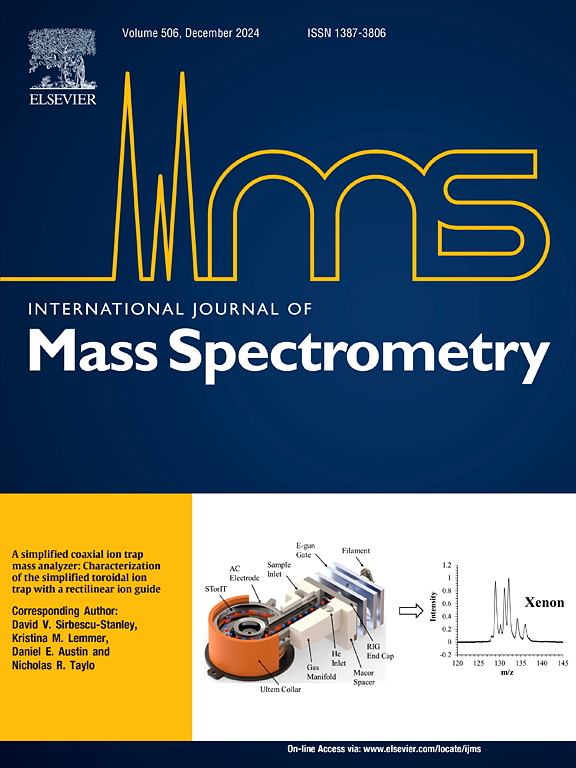GC-MS揭示了苦参树皮提取物中单糖D-Allose对金黄色葡萄球菌生物膜调控蛋白(SrtA和SarA)的作用:一种药物发现方法
IF 1.7
3区 化学
Q3 PHYSICS, ATOMIC, MOLECULAR & CHEMICAL
引用次数: 0
摘要
生物膜相关感染和食源性疾病的流行率不断上升,特别是由金黄色葡萄球菌引起的感染和食源性疾病,由于生物膜引起的抗生素耐药性现象日益增加,对传统治疗策略提出了重大挑战。为此,本研究采用气相色谱-质谱法对传统药用植物马朱那皮的甲醇和正己烷提取物进行了分析,鉴定出多种生物活性化合物。从GC-MS数据中鉴定出的79个化合物与SrtA和SarA的最佳结合评分,这两个关键蛋白参与生物膜的发育和金黄色葡萄球菌的致病性。在79个化合物中,单糖D-Allose与SrtA (- 6.304 kcal/mol)和SarA (- 5.101 kcal/mol)分别通过5个氢键和3个氢键相互作用表现出最佳的结合亲和力。通过100 ns的分子动力学和模拟,分析了与SrtA和SarA的相互作用参数。对应的MM-GBSA结合能值分别为- 33.66 kcal/mol (D-Allose与SrtA)和- 18.09 kcal/mol (D-Allose与SarA)。D-Allose零违反利平斯基五法则的事实进一步证明了它作为候选药物的适用性。这些相互作用表明,D-Allose可能通过与SrtA和SarA相互作用干扰细菌的粘附、群体感应和生物膜基质的合成。据我们所知,这是第一个阐明D-Allose发挥其抗生物膜活性的潜在机制的研究。未来的体外和体内研究应集中在实验验证上,以确定D-Allose是一种有前途的单糖候选物,可用于对抗生物膜相关的耐药金黄色葡萄球菌感染。本文章由计算机程序翻译,如有差异,请以英文原文为准。

GC-MS unveils monosaccharide D-Allose in Terminalia arjuna bark extract acting against biofilm regulatory proteins (SrtA and SarA) of Staphylococcus aureus: A drug discovery approach
The rising prevalence of biofilm-related infections and foodborne diseases, particularly those caused by Staphylococcus aureus, presents significant challenges to conventional treatment strategies due to the increasing phenomenon of antibiotic resistance caused by biofilm. In response, this study employed GC-MS analysis of the methanolic and n-hexane extracts of Terminalia arjuna bark, a traditional medicinal plant, and identified a diverse array of bioactive compounds. All 79 compounds identified from GC-MS data were examined to determine the best binding score with SrtA and SarA, two key proteins involved in the development of biofilms and the pathogenicity of Staphylococcus aureus. Among 79 compounds, D-Allose, a monosaccharide, demonstrated the best binding affinity with SrtA (−6.304 kcal/mol) by involving five hydrogen bonds and SarA (−5.101 kcal/mol) by involving three hydrogen bonds, compared to other compounds among 158 interactions. Molecular dynamics and simulations were performed for 100 ns to analyze the interaction parameters with SrtA and SarA. Corresponding MM-GBSA binding energy values were −33.66 kcal/mol (D-Allose with SrtA), −18.09 kcal/mol (D-Allose with SarA). The fact that D-Allose has zero violations of Lipinski's Rule of Five further exemplifies its suitability as a medication candidate. These interactions suggest that D-Allose may interfere with bacterial adhesion, quorum sensing, and the synthesis of the biofilm matrix by interacting with SrtA and SarA. To the best of our knowledge, this is the first study to elucidate the potential mechanism by which D-Allose exerts its antibiofilm activity. Future research on in vitro and in vivo studies should focus on experimental validation to establish D-Allose as a promising monosaccharide candidate for combating biofilm-related antibiotic-resistant Staphylococcus aureus infections.
求助全文
通过发布文献求助,成功后即可免费获取论文全文。
去求助
来源期刊
CiteScore
3.60
自引率
5.60%
发文量
145
审稿时长
71 days
期刊介绍:
The journal invites papers that advance the field of mass spectrometry by exploring fundamental aspects of ion processes using both the experimental and theoretical approaches, developing new instrumentation and experimental strategies for chemical analysis using mass spectrometry, developing new computational strategies for data interpretation and integration, reporting new applications of mass spectrometry and hyphenated techniques in biology, chemistry, geology, and physics.
Papers, in which standard mass spectrometry techniques are used for analysis will not be considered.
IJMS publishes full-length articles, short communications, reviews, and feature articles including young scientist features.

 求助内容:
求助内容: 应助结果提醒方式:
应助结果提醒方式:


